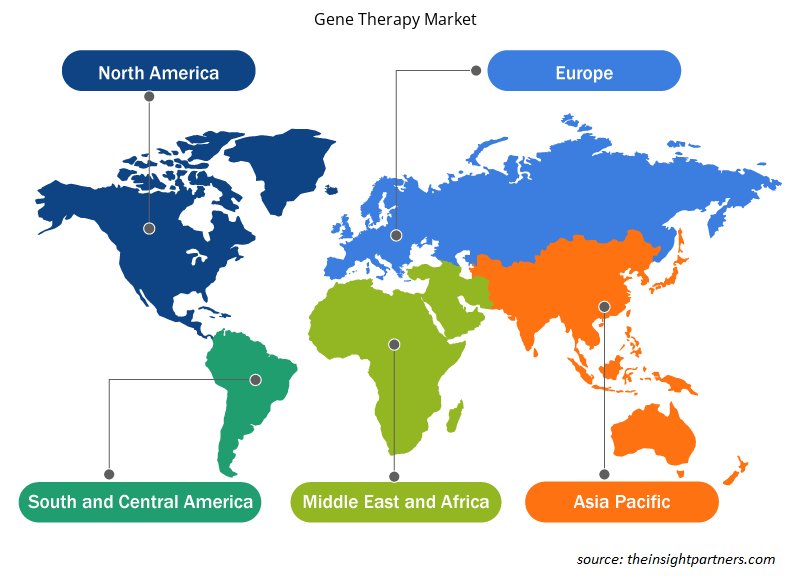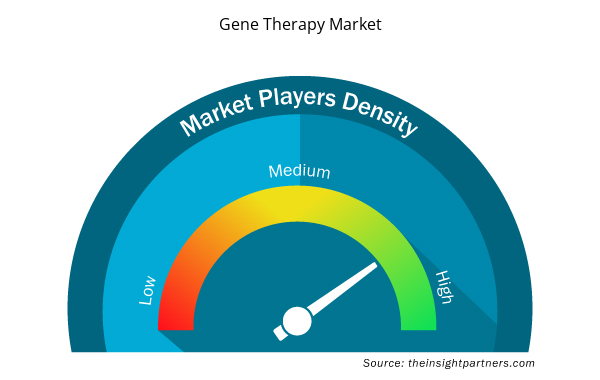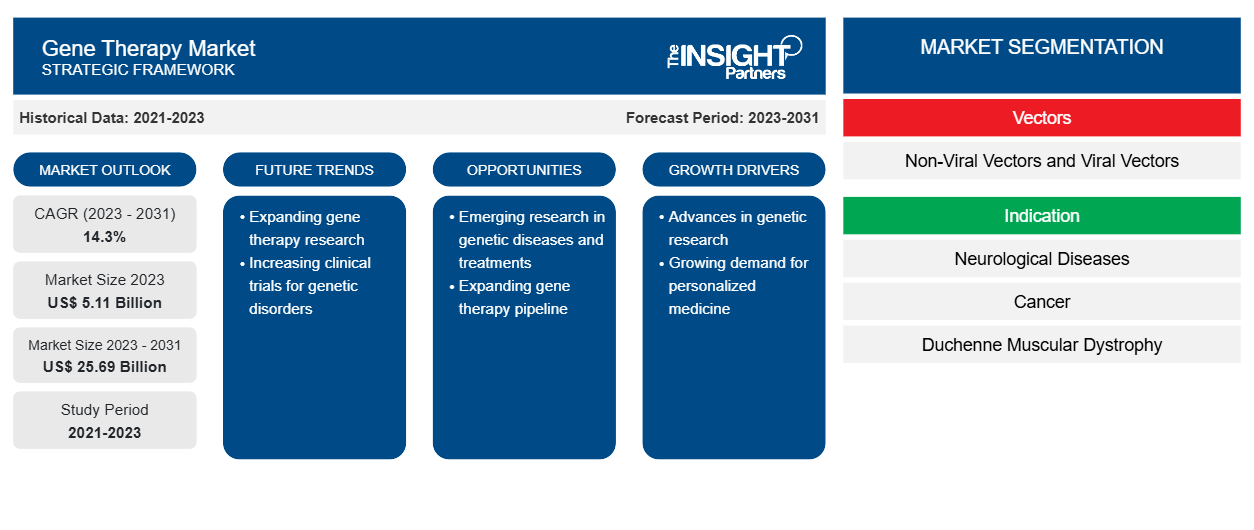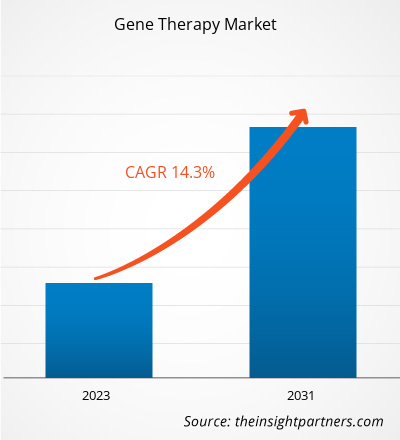[調査レポート] 遺伝子治療市場は、2023年の51億1,000万米ドルから2031年には256億9,000万米ドルに達すると予測されており、2023年から2031年の間に14.3%のCAGRを記録すると予測されています。
市場洞察とアナリストの見解:
遺伝子治療は、病気の原因となる遺伝子を不活性化するか、病気の原因となる遺伝子を健康な遺伝子のコピーに置き換えるか、または新しい遺伝子または改変された遺伝子を体内に導入して病気の治療と予防に役立てるプロセスです。遺伝子治療は、生体内遺伝子治療と生体外遺伝子治療に分類できます。遺伝子治療の目的は、欠陥のある遺伝子を正常な遺伝子に置き換えるか修正することで、正常な機能に必要な正しいタンパク質や酵素を体が生成できるようにし、病気の根本的な原因を治癒できるようにすることです。遺伝性疾患や癌の世界的な蔓延と、FDA による遺伝子治療の承認数の増加は、遺伝子治療市場の成長に有利に働いています。さらに、遺伝子治療市場の動向には、将来的に市場の成長に有利となる遺伝子治療技術の進歩が含まれています。
成長の原動力:
バイオテクノロジーの進歩 により、幅広い適応症に対する治療法が開発されました。遺伝子治療は、がん、神経疾患、遺伝性疾患など、さまざまな疾患の治療に使用されています。米国食品医薬品局 (FDA) が承認した製品が利用できるようになったため、遺伝子治療は世界中で広く採用されています。以下は、近年 FDA が承認した遺伝子治療製品の例です。
- 2023年12月、FDAは鎌状赤血球症に対する2つの細胞ベースの遺伝子治療を承認しました。Bluebird BioのLyfgenia(lovotibeglogene autotemcel)は、血管閉塞の履歴を持つ12歳以上の鎌状赤血球症患者に対して承認されました。これは、Vertex PharmaceuticalsとCRISPR TherapeuticsのCasgevy(exagamglogene autotemcel)とともに承認されました。
- 2023年6月、FDAは、アデノ随伴ウイルスベクターベースの遺伝子治療薬であるロクタビアンを承認しました。これは、アデノ随伴ウイルス血清型5に対する既存の抗体を持たない重症血友病Aの成人の治療薬です。遺伝性血友病Aは、血液凝固を可能にするタンパク質である第VIII因子(FVIII)の生成を担う遺伝子変異により起こる重篤な出血性疾患です。ロクタビアンは、第VIII因子を凝固させる遺伝子を運ぶウイルスベクターを含む、1回限りの遺伝子治療製品です。
- 2023年6月、FDAは、デュシェンヌ型筋ジストロフィー遺伝子の変異が確認され、この治療法による治療を妨げる既往症のない4~5歳の小児患者を対象に、デュシェンヌ型筋ジストロフィーを治療する初の遺伝子治療薬であるElevidysを承認しました。
- 2022年11月、FDAは、CSL Behring LLCが製造する、特定の種類の血友病Bを患う成人患者の治療を目的とした組み換えアデノ随伴ウイルス5型遺伝子治療薬であるHEMGENIXを承認しました。
したがって、これらの遺伝子治療の承認の増加は、遺伝子治療市場の成長を促進しています。
要件に合わせてレポートをカスタマイズする
このレポートの一部、国レベルの分析、Excelデータパックなど、あらゆるレポートを無料でカスタマイズできます。また、スタートアップや大学向けのお得なオファーや割引もご利用いただけます。
- このレポートの主要な市場動向を入手してください。この無料サンプルには、市場動向から見積もりや予測に至るまでのデータ分析が含まれます。
レポートのセグメンテーションと範囲:
遺伝子治療市場分析は、ベクター、適応症、投与方法、および地理のセグメントを考慮して実施されています。ベクターに基づいて、市場は非ウイルスベクターとウイルスベクターに分類されます。適応症に関しては、市場は神経疾患、癌、デュシェンヌ型筋ジストロフィー、肝臓疾患、およびその他の適応症に分類されます。投与方法に関しては、市場は生体内と生体外に分かれています。遺伝子治療市場レポートの範囲は、北米(米国、カナダ、メキシコ)、ヨーロッパ(フランス、ドイツ、英国、スペイン、イタリア、その他のヨーロッパ)、アジア太平洋(中国、日本、インド、オーストラリア、韓国、その他のアジア太平洋)、中東およびアフリカ(サウジアラビア、南アフリカ、UAE、その他の中東およびアフリカ)、南米および中米(ブラジル、アルゼンチン、その他の南米および中米)です。
セグメント分析:
遺伝子治療市場は、ベクター別に、非ウイルスベクターとウイルスベクターに分類されます。ウイルスベクターセグメントは、2023年に大きな市場シェアを占めました。2023年から2030年にかけて、市場でより高いCAGRを記録すると予想されます。
適応症に基づいて、市場は神経疾患、がん、デュシェンヌ型筋ジストロフィー、肝臓疾患、およびその他の適応症に分類されます。がんセグメントは2023年に遺伝子治療市場で大きなシェアを占め、2023年から2030年の間に最高のCAGRを記録すると予測されています。
デリバリーモードに基づいて、市場は生体内と生体外に分割されます。生体内セグメントは2023年に遺伝子治療の大きな市場シェアを占め、2023年から2030年にかけてより高いCAGRを記録すると予想されています。生体内遺伝子治療は体系的な治療を可能にし、体全体の複数の部位や臓器に到達できることを意味します。これは、複数の領域に影響を与える病気や体系的な兆候がある病気に特に役立ち、包括的な治療アプローチを可能にします。さらに、ウイルスベクター、ナノ粒子、脂質ベースのキャリアなどの高度なデリバリー技術の開発により、生体内療法の有効性と特異性が向上しました。これらの進歩により、遺伝物質の標的送達が促進され、治療の安全性と有効性が向上します。
地域分析:
地理的に見ると、遺伝子治療市場は北米、ヨーロッパ、アジア太平洋、中南米、中東アフリカに分かれています。2023年には、北米が市場の大きなシェアを獲得しました。2023年には、米国がこの地域の遺伝子治療市場を支配しました。北米の市場成長は、遺伝性疾患の有病率の増加、がん患者数の増加、政府資金の増加、疾患治療のための高度な遺伝子治療の採用の増加、製品承認の増加に起因しています。
米国疾病管理予防センター(CDC)によると、2020年に米国で約1,603,844件の新たながん症例が診断され、602,347人ががんで亡くなりました。10万人あたり403件の新たながん症例が報告されています。さらに、国際がん研究機関によると、2040年までに新たながん症例は3,020万件に達すると予測されています。2021年10月に発表された米国政府監査院の推定によると、国内の人口の約2,500万~3,000万人が希少疾患に苦しんでおり、希少疾患患者の約50%は子供です。希少疾患は遺伝子変異の結果であることが多く、希少疾患の80%は遺伝性であると推定されています。
国立衛生研究所による2021年10月の最新情報によると、10社の製薬会社と5つの非営利団体が協力し、希少疾患に苦しむ3,000万人のアメリカ人のための遺伝子治療の開発を加速させています。米国FDAは7つの細胞および遺伝子治療薬を承認しており、新製品のパイプラインは約1,200の実験的治療に達しています。これらの半分は第2相臨床試験中であり、Chemical & Engineering Newsレポート2023の推定によると、年間売上高の伸びは細胞治療で15%、遺伝子治療で約30%を占めると推定されています。上記のすべての要因が、この地域の遺伝子治療市場規模の拡大に貢献しています。
遺伝子治療市場の地域別洞察
予測期間を通じて遺伝子治療市場に影響を与える地域的な傾向と要因は、Insight Partners のアナリストによって徹底的に説明されています。このセクションでは、北米、ヨーロッパ、アジア太平洋、中東およびアフリカ、南米および中米にわたる遺伝子治療市場のセグメントと地理についても説明します。

- 遺伝子治療市場の地域別データを入手
遺伝子治療市場レポートの範囲
| レポート属性 | 詳細 |
|---|---|
| 2023年の市場規模 | 51億1千万米ドル |
| 2031年までの市場規模 | 256億9000万米ドル |
| 世界のCAGR(2023年~2031年) | 14.3% |
| 履歴データ | 2021-2023 |
| 予測期間 | 2023-2031 |
| 対象セグメント | ベクトルによる
|
| 対象地域と国 | 北米
|
| 市場リーダーと主要企業プロフィール |
|
遺伝子治療市場のプレーヤー密度:ビジネスダイナミクスへの影響を理解する
遺伝子治療市場は、消費者の嗜好の変化、技術の進歩、製品の利点に対する認識の高まりなどの要因により、エンドユーザーの需要が高まり、急速に成長しています。需要が高まるにつれて、企業は提供内容を拡大し、消費者のニーズを満たすために革新を起こし、新たなトレンドを活用し、市場の成長をさらに促進しています。
市場プレーヤー密度とは、特定の市場または業界内で活動している企業または会社の分布を指します。これは、特定の市場スペースに、その規模または総市場価値と比較して、どれだけの競合相手 (市場プレーヤー) が存在するかを示します。
遺伝子治療市場で事業を展開している主要企業は次のとおりです。
- ノバルティスAG
- アステラス製薬株式会社
- ブリストル・マイヤーズ スクイブ社
- ブルーバードバイオ株式会社
- サノフィ
免責事項:上記の企業は、特定の順序でランク付けされていません。

- 遺伝子治療市場のトップキープレーヤーの概要を入手
業界の発展と将来の機会:
市場参加者が実施したいくつかの取り組み世界の遺伝子治療市場は以下の通りです。
- 2022年1月、Ori Biotech Ltdは、市場に革新的な細胞および遺伝子治療製造プラットフォームを導入するために、応募超過のシリーズB資金調達ラウンドで1億米ドル以上を確保しました。
- 2020年1月、アステラス製薬株式会社はAudentes Therapeutics, Inc.を買収しました。この買収により、合併後の会社はAAVベースの遺伝子医療の世界的リーダーとなることができます。
競争環境と主要企業:
遺伝子治療市場の予測は、関係者が成長戦略を計画するのに役立ちます。遺伝子治療市場レポートで紹介されている主な企業には、ノバルティス AG、アステラス製薬、ブリストル・マイヤーズ スクイブ、ブルーバード バイオ、CSL ベーリング、サノフィ、F. ホフマン・ラ・ロシュ、第一三共、バイオジェン、オックスフォード バイオメディカなどがあります。これらの企業は、世界中で高まる消費者の需要を満たすために、新しいハイテク製品の導入、既存製品の改良、地理的拡大に重点を置いています。
- 過去2年間の分析、基準年、CAGRによる予測(7年間)
- PEST分析とSWOT分析
- 市場規模価値/数量 - 世界、地域、国
- 業界と競争環境
- Excel データセット


- Artificial Intelligence in Defense Market
- Aerospace Forging Market
- Parking Management Market
- Virtual Pipeline Systems Market
- Vision Guided Robotics Software Market
- Analog-to-Digital Converter Market
- Mobile Phone Insurance Market
- Retinal Imaging Devices Market
- Arterial Blood Gas Kits Market
- Workwear Market

Report Coverage
Revenue forecast, Company Analysis, Industry landscape, Growth factors, and Trends

Segment Covered
This text is related
to segments covered.

Regional Scope
North America, Europe, Asia Pacific, Middle East & Africa, South & Central America

Country Scope
This text is related
to country scope.
よくある質問
The gene therapy market majorly consists of the players, including Novartis AG, Astellas Pharma Inc., Bristol-Myers Squibb Company, Bluebird Bio Inc., CSL Behring, Sanofi, F. Hoffmann-La Roche Ltd, Daiichi Sankyo, Biogen, and Oxford Biomedica.
The gene therapy market was valued at US$ 5.11 billion in 2023.
The factors driving the growth of the gene therapy market include the increasing burden of genetic diseases and the rising number of FDA approvals of gene therapies. However, the high cost of gene therapy products hampers the growth of the gene therapy market.
The gene therapy market is expected to be valued at US$ 25.69 billion in 2031.
The global gene therapy market is segmented based on vectors, indication, and delivery mode. Based on indication, the gene therapy market is categorized into neurological diseases, cancer, Duchenne muscular dystrophy, hepatological diseases, and other indications. The cancer segment held a significant market share in 2023 and is anticipated to record the highest CAGR in the market during 2023–2031.
Gene therapy is a process for the treatment of diseases by inactivating a disease-causing gene, replacing a disease-causing gene with a healthy copy of the gene, or introducing a new or modified gene into the body to help treat and prevent the disease.
Trends and growth analysis reports related to Life Sciences : READ MORE..
The List of Companies - Gene Therapy Market
- Novartis AG
- Astellas Pharma Inc.
- Bristol-Myers Squibb Company
- Bluebird Bio Inc.
- Sanofi
- F. Hoffmann-La Roche Ltd
- Daiichi Sankyo
- CSL Behring
- Biogen
- Oxford Biomedica.
The Insight Partners performs research in 4 major stages: Data Collection & Secondary Research, Primary Research, Data Analysis and Data Triangulation & Final Review.
- Data Collection and Secondary Research:
As a market research and consulting firm operating from a decade, we have published and advised several client across the globe. First step for any study will start with an assessment of currently available data and insights from existing reports. Further, historical and current market information is collected from Investor Presentations, Annual Reports, SEC Filings, etc., and other information related to company’s performance and market positioning are gathered from Paid Databases (Factiva, Hoovers, and Reuters) and various other publications available in public domain.
Several associations trade associates, technical forums, institutes, societies and organization are accessed to gain technical as well as market related insights through their publications such as research papers, blogs and press releases related to the studies are referred to get cues about the market. Further, white papers, journals, magazines, and other news articles published in last 3 years are scrutinized and analyzed to understand the current market trends.
- Primary Research:
The primarily interview analysis comprise of data obtained from industry participants interview and answers to survey questions gathered by in-house primary team.
For primary research, interviews are conducted with industry experts/CEOs/Marketing Managers/VPs/Subject Matter Experts from both demand and supply side to get a 360-degree view of the market. The primary team conducts several interviews based on the complexity of the markets to understand the various market trends and dynamics which makes research more credible and precise.
A typical research interview fulfils the following functions:
- Provides first-hand information on the market size, market trends, growth trends, competitive landscape, and outlook
- Validates and strengthens in-house secondary research findings
- Develops the analysis team’s expertise and market understanding
Primary research involves email interactions and telephone interviews for each market, category, segment, and sub-segment across geographies. The participants who typically take part in such a process include, but are not limited to:
- Industry participants: VPs, business development managers, market intelligence managers and national sales managers
- Outside experts: Valuation experts, research analysts and key opinion leaders specializing in the electronics and semiconductor industry.
Below is the breakup of our primary respondents by company, designation, and region:

Once we receive the confirmation from primary research sources or primary respondents, we finalize the base year market estimation and forecast the data as per the macroeconomic and microeconomic factors assessed during data collection.
- Data Analysis:
Once data is validated through both secondary as well as primary respondents, we finalize the market estimations by hypothesis formulation and factor analysis at regional and country level.
- Macro-Economic Factor Analysis:
We analyse macroeconomic indicators such the gross domestic product (GDP), increase in the demand for goods and services across industries, technological advancement, regional economic growth, governmental policies, the influence of COVID-19, PEST analysis, and other aspects. This analysis aids in setting benchmarks for various nations/regions and approximating market splits. Additionally, the general trend of the aforementioned components aid in determining the market's development possibilities.
- Country Level Data:
Various factors that are especially aligned to the country are taken into account to determine the market size for a certain area and country, including the presence of vendors, such as headquarters and offices, the country's GDP, demand patterns, and industry growth. To comprehend the market dynamics for the nation, a number of growth variables, inhibitors, application areas, and current market trends are researched. The aforementioned elements aid in determining the country's overall market's growth potential.
- Company Profile:
The “Table of Contents” is formulated by listing and analyzing more than 25 - 30 companies operating in the market ecosystem across geographies. However, we profile only 10 companies as a standard practice in our syndicate reports. These 10 companies comprise leading, emerging, and regional players. Nonetheless, our analysis is not restricted to the 10 listed companies, we also analyze other companies present in the market to develop a holistic view and understand the prevailing trends. The “Company Profiles” section in the report covers key facts, business description, products & services, financial information, SWOT analysis, and key developments. The financial information presented is extracted from the annual reports and official documents of the publicly listed companies. Upon collecting the information for the sections of respective companies, we verify them via various primary sources and then compile the data in respective company profiles. The company level information helps us in deriving the base number as well as in forecasting the market size.
- Developing Base Number:
Aggregation of sales statistics (2020-2022) and macro-economic factor, and other secondary and primary research insights are utilized to arrive at base number and related market shares for 2022. The data gaps are identified in this step and relevant market data is analyzed, collected from paid primary interviews or databases. On finalizing the base year market size, forecasts are developed on the basis of macro-economic, industry and market growth factors and company level analysis.
- Data Triangulation and Final Review:
The market findings and base year market size calculations are validated from supply as well as demand side. Demand side validations are based on macro-economic factor analysis and benchmarks for respective regions and countries. In case of supply side validations, revenues of major companies are estimated (in case not available) based on industry benchmark, approximate number of employees, product portfolio, and primary interviews revenues are gathered. Further revenue from target product/service segment is assessed to avoid overshooting of market statistics. In case of heavy deviations between supply and demand side values, all thes steps are repeated to achieve synchronization.
We follow an iterative model, wherein we share our research findings with Subject Matter Experts (SME’s) and Key Opinion Leaders (KOLs) until consensus view of the market is not formulated – this model negates any drastic deviation in the opinions of experts. Only validated and universally acceptable research findings are quoted in our reports.
We have important check points that we use to validate our research findings – which we call – data triangulation, where we validate the information, we generate from secondary sources with primary interviews and then we re-validate with our internal data bases and Subject matter experts. This comprehensive model enables us to deliver high quality, reliable data in shortest possible time.


 このレポートの無料サンプルを入手する
このレポートの無料サンプルを入手する